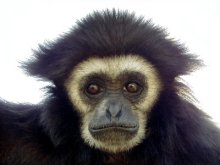This family contains 1 genus, Hylobates, and approximately 11 species (some authorities recognize a second genus, Symphalangus) . They are found only in the tropical forests of southeastern Asia, including on Sumatra, Borneo, Java, and other islands as well as the mainland. These apes are of medium size (3.9-12.7 kg). They lack tails. Their forearms are remarkably long, and both forefeet and hindfeet are long and thin. The forefeet have a deep cleft between first and second digits. The pelage of these apes is usually black, gray, or brownish, often with white markings on hands, feet, and facial region. Ischial callosities are present. Some gibbons and siamangs have an enlarged throat sac, which inflates and serves as a resonating chamber when the animals call. This structure is enormous in a few species, equalling the size of the animal's head.
Hylobatidae
gibbons and siamangs
The skulls of hylobatids resemble those of hominids, with very short rostra, enlarged braincases, and large orbits that face forward. Hylobatds are catarrhine primates; that is, their nostrils are close together and face forward and slightly downward. They lack cheek pouches and their stomach is not sacculated. Their teeth are similar to those of hominids. The molars are bunodont and lack lophs. The upper molars usually have a cingulum, which is sometimes large. The canines are prominent (more so than in most hominids) but not sexually dimorphic. The dental formula is 2/2, 1/1, 2/2, 3/3 = 32.
Gibbons and siamangs are monogamous, living in small family troops of usually 2-6 related individuals. These groups are territorial, maintaining their territories partly by conspicuous vocalization, which may involve loud duetting by group members. They are primarily vegetarian, feeding on figs and other fruit, leaves and shoots. They are remarkably active and agile brachiators, capable of exceeding 3m in a swing. Gibbons leap from branch to branch, sometimes travelling more than 9 m in a single leap. They also sometimes walk on large branches or on ground, assuming a bipedal stance with their arms raised for balance. Gibbons are active during the day.
Fossil hylobatids are known from the Miocene.
HOME
Primates
Primate FAQ
Gibbon Pictures
Primate Species
Siamang Pictures
Search Primates.com
Primates E-Mail Service
